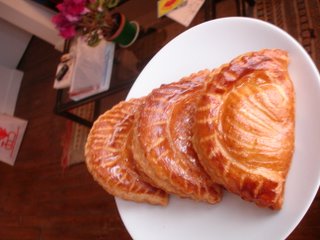

Today we made chausson aux pommes and palmiers. Palmier in French means "palm tree" so I suppose it is meant to look like dried palm leaves shaped into a heart. Or maybe it’s supposed to look like the leaf of a royal palm…I remember being in Mexico one time over Easter and seeing many palm leaf sculptures on the street--each time I pass these in the bakery window, I remember Mexican Easter. And so, in this way, "palmiers" have always looked and felt like very Catholic pastries to me.
I had my first bite of one today; I suppose they're tasty enough with a cup of tea or coffee. A palmier consists only of pastry dough (phyllo) and sugar. So the quality of the palmier depends entirely on the quality of the phyllo, which depends on the quality mainly of the butter. We used fancy French butter, which (naturally!) is quite good. The chausson aux pommes is as I mentioned before a croissant with apples inside.
What was most amusing today in practice was not actually what we made, but a little lesson I learned in French culinary pride.
There are a team of 5 chefs who alternate giving the demonstrations and monitoring the practical course. Some of these chefs are pastry chefs, some are highly acclaimed bakers (a distinction made by training and nature of experience). The chef who gives the demonstration is responsible for having the class know what to do, as the “recipes” we’re given are simply a list of ingredients; we have no instructions whatsoever…not even the baking temperatures or times. Unfortunately, you are not guaranteed to have the same chef in practice as in the demo. This results in scenes like the following:
20-year-old Korean girl, 4’11, hunched over her baking sheet of palmiers, meticulously separating the ends of each so that they flare open in the oven…as we had been shown in demonstration. 6’1, roughly 250-pound French chef storms over to her baking station, startling her into dropping a palmier on the floor. She looks up at him with eyes wide, mouth round, hands stunned into the mid-air, fingers spread position they had been in when she dropped her pastry. Beadlets of sweat have begun to form on the chef’s reddening temple, just beneath the brim of his chef’s hat. He swiftly gathers his eyebrows together and bellows, bending toward her, “Mais qu’est que vous faîtes?!!! C’est quoi ce bazaar, ce magique circus?! On ne plie pas les bouts comme ça! Oh la la la la! Qui vous a dit de faire ce cinéma?” [What are you doing?!!! What’s this disaster, this magic circus (the chef’s own language tic; not a valid French expression)?! You don’t fold the ends like that! Oh la la la la! Who told you to do that garbage?]
girl: (silence. She doesn’t move a muscle).
Chef: “Et alors?!” [so?]
girl’s friend: “she doesn’t speak French, chef”
Chef: “oo told you making zis magique circoos cinema tra la la?!”
(indicates the folded out portions of her pastries with a disdainful swoosh of his forefinger)
girl’s friend: “she doesn’t speak English either.”
Chef: “MAIS ALORS TRADUISEZ, NOM DE DIEU!!!” [Then good god translate!!!] (he dramatically rips off his hat and begins to storm down the hallway).
A moment later we hear, “C’est un truc de BOU-LAN-GER, ça! Et moi je suis PA-TI-SSIER!” [That’s a baker’s trick! And I’m a pastry chef!!]
Apparently, our demo chef had been a humble baker from the south of France.
None of us will ever fold out the ends of the palmiers again. Except maybe for the Korean girl, because her friend never translated for her.
1 comment:
i'm imagining you tell that story and it made laugh...
just let me know when your class covers chocolate-covered strawberries...
Post a Comment